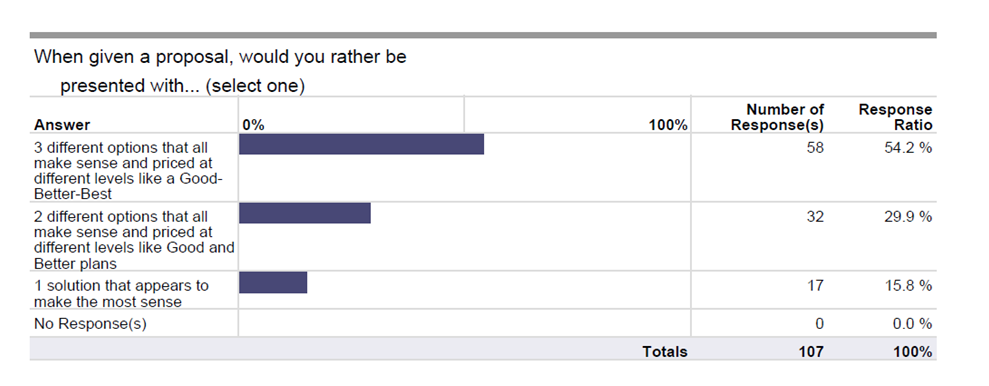Two of the top recommendations we make in our sales development engagements are 1) don’t waste time on unqualified buyers, and 2) seek to achieve a 100% closing rate on all qualified buyers.
This article focuses on the second lesson – seek to achieve a 100% closing rate on qualified buyers, and offers a proven method for achieving a high sales closing rate.
The method is called ZOPA – Zone of Proposal Acceptance. It seeks to align the buyer’s desires and budgets with the salesperson’s solutions by offering the buyer choices. This method not only is proven to be successful, it also aligns with the buyer’s desire for options.
Buyers prefer options
As part of the research I did for my upcoming book, buyers were asked about their preferences when reviewing sales proposals. The survey asked buyers if they preferred to be presented one sensible solution vs. 2 or 3 options. Here’s what we asked and what they said… 
More than 8 out of 10 buyers want to be presented with choices. Give your buyers what they want and you get more of what you want – closed sales. That’s why ZOPA is so effective.
How to apply ZOPA
Applying the ZOPA method results in offering your buyers Good-Better-Best options. Follow these 5 steps…
Step 1 - Get a sense for your buyer’s budget. Our survey revealed that more than three-quarters of buyers are at least somewhat comfortable telling the salesperson what the budget is. Obtain some information about the budget and use that to assemble your choices.
Step 2 – Determine how your products and services can add value to your buyer, can solve his problems, and can help him achieve his business goals. Determine all the various services, features, tactics and strategies that you can apply to the situation, and list them in order of cost, from low to high.
Step 3 – Determine your first choice – the “Good” option - the least expensive of the three options you will be proposing to your buyer. This first option should be priced so that it fits easily with your buyer’s budget, almost ensuring you will not get a price objection. Do this by including in your first option the services, features, tactics and strategies that will achieve the goals, and the overall investment fits easily into the budget.
Step 4 – Determine your top choice – the “Best” option - the most expensive of the three options you will be proposing to your buyer. This top option includes all the items you determined are appropriate in Step 2.
Step 5 – Determine your middle option – the “Better” option. This one is the trickiest to assemble. Ideally, you want to assemble the features and services that result in this option being priced about midway between the least expensive option and the most expensive option, but a little closer to the top option.
Step 6 – Once you’ve determined what your three options include and how they are priced, assemble them into your proposal in a way that you can easily communicate them to your buyer.
Statistically, about two-thirds of your buyers will choose the middle option.
You can choose your own terminology. Using “Good-Better-Best” isn’t a requirement. I’ve seen options titled “Silver-Gold-Platinum”, “Fast-Faster-Fastest” and other labels. Make your naming plan work for your buyers, whatever make sense.
In summary, you can increase your sales closing rate by offering options to your buyers. As long as the options you present will truly add value and contribute to your buyer’s success, you will experience a higher sales closing rate and may also find you are increasing the average size of your sale.





Agree, disagree, or just have something to add?
Leave a comment below.